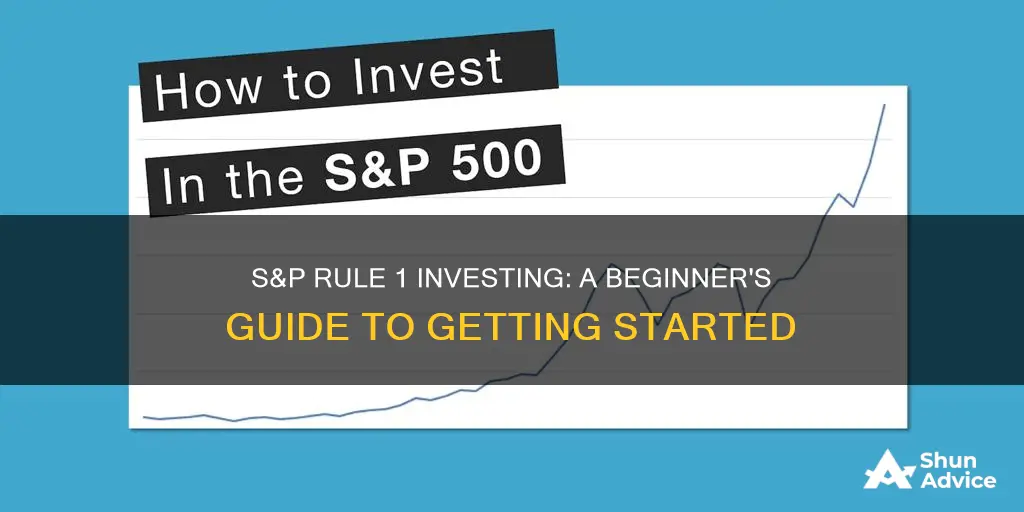
The S&P 500 index is a popular choice for investors looking to invest in the top 500 publicly traded U.S. companies. While it is not designed to beat the broader stock market, it is built to match it. The index includes companies across sectors, from energy to healthcare, and information technology.
There are two main ways to invest in the S&P 500: through individual stocks or through an index fund, such as a mutual fund or exchange-traded fund (ETF). Mutual funds and ETFs are similar but differ in that ETFs can be traded like stocks throughout the day, while mutual funds can only be traded once a day at the end of each trading day.
When investing in the S&P 500, it is important to consider the fees involved, such as the expense ratio, which is an annual fee charged as a percentage of your total fund investment. It is also worth noting that S&P 500 stocks tend to be more expensive than average stocks.
Before investing in the S&P 500, it is recommended to get familiar with how it works, the opportunities it brings, and the associated risks.
| Characteristics | Values |
|---|---|
| What is the S&P 500? | The S&P 500, short for Standard & Poor's 500 index, is an index of the top 500 publicly traded large U.S. companies. |
| How to invest in the S&P 500 | You can't invest directly in the S&P 500 index. You can buy individual stocks of S&P 500 companies or buy an S&P 500 index fund through a mutual fund or ETF. |
| How much does it cost to invest in the S&P 500? | The difference in fees between S&P 500 index funds and ETFs is marginal. For example, Vanguard's S&P 500 ETF (VOO) has an expense ratio of 0.03%, while the Vanguard 500 Index Fund Admiral Shares (VFIAX) has an expense ratio of 0.04%. |
| Advantages of investing in the S&P 500 | Exposure to the world's most dynamic companies, consistent long-term returns, intricate analysis not required, can serve as a core holding. |
| Disadvantages of investing in the S&P 500 | The index is dominated by large-cap companies, the index has risks inherent in equity investing, and it only includes U.S. companies. |
What You'll Learn

Buying individual stocks vs. index funds
When building an investment portfolio, it is important to consider the advantages and disadvantages of both individual stocks and index funds before investing.
When you buy shares of stock in a company, you are purchasing partial ownership of that company and sharing in its profits and losses based on its performance. You can profit when each individual share becomes worth more than what you paid for it, or when you receive dividends, which are a percentage of the company's profits paid to shareholders. However, if the company fails or struggles, your shares' value can drop or become worthless.
An index fund is a collection of stocks purchased to track a particular index, such as the S&P 500 or the Dow Jones Industrial Average. Owning shares in an index fund means you own individual stocks in a variety of companies indirectly, without needing to study and select individual companies. This tends to be more favourable for individual investors due to lower costs and reduced need for research and analysis.
Advantages of Index Funds
Index funds present lower risk because they are managed by fund managers who cut losses and replace failing companies. The best-known index, the S&P 500, is highly unlikely to see all its companies fail, even in a crash or recession. Index funds also tend to exceed the returns gained on other funds, and they require less active management, reducing interaction and transaction fees.
Disadvantages of Index Funds
Index funds will never increase many times over in a year, so they offer lower potential returns than individual stocks. They also provide limited exposure to different strategies, as there are countless successful investing strategies that an index fund may not be able to take advantage of. Additionally, investors have no control over the individual holdings in the portfolio.
Final Thoughts
When deciding whether to invest in individual stocks or index funds, it is recommended to do a bit of both. Investing most or all your money in individual stocks is risky, while investing exclusively in index funds may offer much lower returns. A good strategy is to keep most of your investment dollars in safer investments such as index funds, and use the rest to speculate on more individual stocks.
Will County Workforce Investment Board: Building a Stronger Community Through Employment Initiatives
You may want to see also

Mutual funds vs. exchange-traded funds (ETFs)
Mutual funds and exchange-traded funds (ETFs) are two popular investment vehicles that offer investors a low-cost way to gain exposure to a diversified portfolio of securities. While both investment options have similarities, there are some critical differences to consider.
Similarities Between Mutual Funds and ETFs
Mutual funds and ETFs are similar in that they both represent managed "baskets" or "pools" of individual securities, such as stocks or bonds. They offer investors exposure to a wide variety of asset classes and niche markets, providing more diversification than investing in a single stock or bond. By combining funds from multiple asset classes, investors can create a well-diversified portfolio.
Differences Between Mutual Funds and ETFs
Management Style
Mutual funds come in both active and indexed varieties, but most are actively managed by fund managers. On the other hand, ETFs are typically passive investments pegged to the performance of a particular index, although they can also be actively managed. Actively managed mutual funds aim to outperform the market, while ETFs aim to mirror the performance of an index.
Trading and Liquidity
ETFs trade like stocks on a stock exchange and can be bought and sold throughout the day, experiencing price changes in real time. Mutual funds, on the other hand, are bought and sold through a fund house only once per day at the end of the trading day, and all investors receive the same price, known as the Net Asset Value (NAV). This makes ETFs more liquid than mutual funds.
Minimum Investment
ETFs do not require a minimum initial investment, and investors can purchase them as whole shares at the market price. Mutual funds, however, usually have a flat dollar amount as a minimum initial investment, and they can be purchased in fractional shares or fixed dollar amounts.
Costs and Tax Efficiency
While ETFs have lower expense ratios than mutual funds, they may have trading fees and implicit costs, such as the bid/ask spread and premium/discount to NAV. Mutual funds may be purchased without trading commissions, but they often carry other fees, such as sales loads or early redemption fees.
ETFs are generally more tax-efficient than mutual funds because they generate fewer capital gains for investors due to lower turnover and the ability to use the in-kind creation/redemption process to manage the cost basis of their holdings. Selling securities within a mutual fund may trigger capital gains for shareholders, even if they have an unrealized loss on the overall investment.
Investor Considerations
When deciding between ETFs and mutual funds, investors should consider their investment goals, risk tolerance, and investment horizon. ETFs are ideal for investors who want to make intraday trades, use stop orders, limit orders, options, or short selling, as these are not possible with mutual funds. ETFs are also a good choice for tax-sensitive investors due to their tax efficiency.
Mutual funds, specifically no-load index mutual funds, can be a cost-effective option for investors who make regular deposits using a dollar-cost averaging strategy, as they allow investors to fully invest the same dollar amount each time by purchasing fractional shares. Additionally, in less efficient markets, such as high-yield bonds or emerging markets, mutual funds may provide greater opportunities for active portfolio management.
Both mutual funds and ETFs have their advantages and disadvantages, and the choice between the two depends on the investor's goals, risk tolerance, and preferences. ETFs are generally lower-cost and provide more liquidity, while mutual funds offer a broader range of asset classes and the potential for tax-free long-term gains. Investors should carefully consider their investment strategy and decide which option aligns better with their financial objectives.
Mortgage Lenders: Your Investment Papers, Please!
You may want to see also

Index funds vs. stock futures
Index funds and stock futures are two very different investment vehicles, each with its own advantages and disadvantages. Here is a detailed comparison of the two:
Index Funds:
Index funds are a type of investment fund that aims to replicate the performance of a specific stock market index, such as the S&P 500. Index funds are passively managed, meaning they aim to mirror the index's performance rather than trying to outperform it. This means that index funds have lower fees than actively managed funds, making them more affordable for investors.
Index funds provide broad market exposure and diversification, as they invest in a large number of companies within the index. For example, the S&P 500 index fund invests in 500 leading U.S. companies across various sectors, including information technology, financials, and healthcare. This diversification helps to minimize the effects of market volatility and reduce risk.
Index funds are ideal for investors who want a hands-off approach to investing, as they do not require intensive stock-picking research. They are also suitable for long-term wealth-building, as the S&P 500 has historically provided consistent annual returns over the long term.
However, one disadvantage of index funds is that they are dominated by large-cap companies, which means they have limited exposure to small-cap and mid-cap stocks with potentially higher growth rates. Additionally, index funds only include U.S. companies, limiting international stock exposure.
Stock Futures (Index Futures):
Stock futures, also known as index futures, are a type of derivative contract. They are agreements to buy or sell a financial index, such as the S&P 500, at a set price on a specific future date. Unlike index funds, stock futures can be used for speculation on the direction of the market or for hedging against potential losses.
Stock index futures are traded on exchanges through futures brokers and are settled daily in cash, rather than delivering the underlying index. This means that investors pay or collect the difference in value each day, based on the performance of the index. Stock futures are more flexible than index funds in terms of trading, as they can be traded nearly 24/7 on electronic trading platforms.
Stock futures can be a sophisticated trading strategy, allowing investors to bet on the direction of a group of assets without buying individual stocks. They can also be used as a hedging tool to offset potential losses in a portfolio. However, speculation with stock futures is high risk, as unforeseen events can cause the index to move in the opposite direction.
Additionally, stock futures may require higher capital investments, as they are typically aimed at institutional investors. To mitigate this, smaller investors can consider fractional index futures, such as the E-mini S&P 500, which trades at a lower price.
Kentucky Teacher Retirement System: Unveiling the Investment Portfolio
You may want to see also

Brokerage accounts
A brokerage account is a necessary tool for any investor looking to buy stocks, bonds, mutual funds, or other investment vehicles. This includes those wanting to invest in the S&P 500. When opening a brokerage account, you will need to decide which type of account suits your needs. There are several types of brokerage accounts to choose from, each with its own advantages and disadvantages. A standard brokerage account is the most common type and offers a wide range of investment options, including stocks, bonds, ETFs, and mutual funds. You can open this account with most banks or dedicated investment brokerages. This account type typically offers more flexibility in terms of investment choices and provides easy access to your funds. However, standard brokerage accounts do not offer the same tax advantages as retirement-specific accounts.
Retirement accounts, such as Traditional IRAs or Roth IRAs, offer tax benefits that can help your investments grow faster. With a Traditional IRA, you may be able to deduct your contributions from your taxable income, reducing your tax liability. On the other hand, with a Roth IRA, your withdrawals in retirement are typically tax-free, providing a significant long-term benefit. These accounts do come with contribution limits and restrictions on withdrawals, so it's important to understand the rules before opening this type of account. If you are investing for the long term and do not need immediate access to your funds, retirement accounts can be a great way to maximize your investments through tax advantages.
Another type of brokerage account to consider is a managed or advisory account. With this type of account, you can get professional investment advice and guidance. Managed accounts typically offer a more hands-off approach, as a financial advisor or investment manager handles the day-to-day investment decisions according to your specific goals and risk tolerance. While these accounts often come with additional fees, they can provide valuable expertise and save you time and effort in managing your investments. Self-directed brokerage accounts are also an option, where you make all the investment decisions yourself. These accounts typically offer a wider range of investment choices, including alternative investments such as futures, options, and forex.
When choosing a brokerage firm, it's important to consider the fees and commissions charged for trades, account maintenance, and any additional services. Some brokerages offer discounted commissions or even free trades, while others may charge higher fees but provide more comprehensive research tools, investment guidance, or customer support. It's also worth checking the account minimums required, as some brokerages require a minimum balance to open an account or to access certain features. Additionally, look for a user-friendly platform that suits your investment style and provides the tools and resources you need to make informed decisions. Reviewing the research and analysis tools offered by the brokerage can help you make more strategic investment choices, especially if you plan to actively manage your own investments.
The Power of Early Retirement Investing: Why Starting Now Pays Off
You may want to see also

Expense ratios
When considering how to buy S&P Rule 1 Investing, it is important to understand the concept of expense ratios. An expense ratio is the cost of owning a mutual fund or exchange-traded fund (ETF) and is usually measured as a percentage of your investment in the fund. For example, a fund with a 0.30% expense ratio means you will be charged $30 per year for every $10,000 you have invested in that fund.
When determining a good expense ratio, it is essential to consider the type of fund. For actively managed funds, a reasonable expense ratio is typically between 0.5% and 0.75%, while a ratio above 1.5% is generally considered high. On the other hand, passive funds, which require less research and trading of securities, tend to have lower expense ratios, with an average of about 0.12%.
When investing in the S&P 500, it is worth noting that S&P 500 index funds tend to have slightly higher fees than ETFs due to their higher operating expenses. However, S&P 500 ETFs still offer low expense ratios, with some of the biggest and most popular options having ratios below 0.10%. For example, Vanguard's S&P 500 ETF (VOO) has an expense ratio of 0.03%.
When choosing an S&P 500 index fund or ETF, it is important to consider the expense ratio, as a lower ratio will result in higher returns for the investor. By comparing expense ratios and selecting funds with competitive ratios, investors can save tens of thousands of dollars over their investing career.
Safe Havens: Where to Invest Now
You may want to see also
Frequently asked questions
The S&P 500, short for Standard & Poor's 500, is an index that tracks the performance of the top 500 publicly traded large U.S. companies. It was first launched in 1957 and is considered a gauge of U.S. stock market performance.
There are a few ways to invest in the S&P 500:
- Direct stock purchases: You can buy stocks of individual companies in the S&P 500 through online stock-trading platforms.
- Index funds: You can buy index funds that mirror the S&P 500, which is a low-cost way to gain exposure to the biggest publicly traded stocks.
- Exchange-traded funds (ETFs): ETFs are similar to index funds but can be traded at any point during the stock exchange trading day. They tend to have lower operating expenses than regular index funds.
Investing in the S&P 500 provides broad exposure to some of the largest and most dynamic companies in the U.S., such as Apple, Amazon, and Microsoft. It offers consistent long-term returns with an average annualized return of around 11-12% over the past few decades. Additionally, it provides instant diversification across various sectors and reduces the need for intricate analysis of individual stocks.
The S&P 500 is dominated by large-cap companies, so it has limited exposure to small-cap and mid-cap stocks. It is also subject to the volatility of the stock market and only includes U.S. companies, providing no international diversification.
When choosing between an S&P 500 index fund and ETF, consider the following:
- Minimum investment: ETFs typically have lower minimum investment requirements, sometimes allowing you to buy a single share.
- Expense ratio: Compare the expense ratios, which represent the ongoing cost of holding the investment, and choose the option with the lowest ratio.
- Dividend yield: Compare the dividend yields and select the option with a higher yield to boost your returns.







